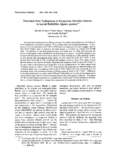Transition from endogenous to exogenous nutrition sources in larval rabbitfish Siganus guttatus
Share
Abstract
The early larval development of Siganus guttatus was studied with emphasis on the transition from endogenous to exogenous feeding. Three rearing trials were conducted as follows: 1) rearing in a 5 ton concrete tank at 27.9-29.3oC (T-85 trial); 2) rearing in a 0.5 ton fiberglass tank at 22.2-26.5oC (T-86A trial); 3) rearing in the same manner as in T-86A but without food (T-86B trial). On the basis of the developmental events and energy flow in T-86A trial, the early life history of the species could be divided into the following seven phases: 1) rapid larval growth due to rapid yolk resorption (from hatching to about 15 h after hatching (time after hatching: TAH)); 2) slow growth and organogenesis based mainly on yolk energy (to about 50 h TAH); 3) slow growth based on energy of yolk, oil globule and exogenous food (to about 50 h TAH); 4) slow growth based on two sources of energy, oil globule and exogenous food (to about 90 h TAH); 5) the same mode of development and energy flow as in the preceding phase, but with a certain level of feeding amount (to about 120 h TAH); 6) accelerated larval growth and effective feeding and swimming based only on exogenous food (to about 150 h TAH); and 7) the same mode as in the preceding phase with accelerated increase of feeding amount (beyond 150 h TAH). Differences in developmental mode were observed in T-85 and T-86A trials, but it could not be ascertained in this particular study which of the environment factors played the greatest influence. The results of T-86A and B showed that the larvae, in order to survive, have to get over two obstacles on feeding, that is, to start feeding and to change from endogenous to exogenous feeding suitably.
Description
Contribution No. 257 of the SEAFDEC Aquaculture Department.
Suggested Citation
Kohno, H., Hara, S., Duray, M., & Gallego, A. (1988). Transition from endogenous to exogenous nutrition sources in larval rabbitfish Siganus guttatus. Nippon Suisan Gakkaishi , 54(7), 1083-1091. http://hdl.handle.net/10862/1285
Subject
Collections
- AQD Journal Articles [1240]


